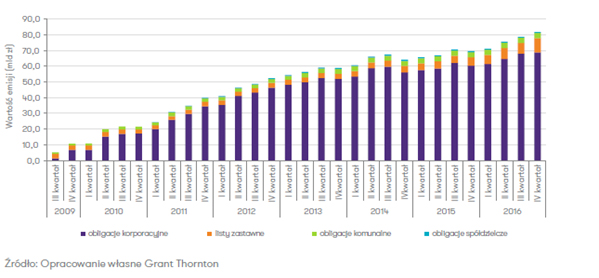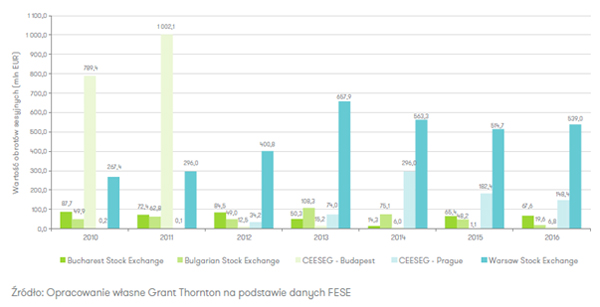- The value of non-Treasury debt listed on Catalyst reached PLN 81.8 billion at the end of Q4 2016 according to a Grant Thornton report published under the auspices of the Warsaw Stock Exchange
- This was the highest value since Catalyst was launched
- In 2016 the value of instruments listed on Catalyst did not fall quarter on quarter for the first time in three years
The audit, consultancy and outsourcing provider Grant Thornton has completed its fifth analysis of the Catalyst debt market. The developments noted last year prove that Catalyst, which opened in September 2009, is more than a trading venue for Treasury debt, and that the growing segment of corporate bonds still represents an attractive alternative to bank debt and the equity market.
This is confirmed by the statistics of Catalyst value and size. As at 2016 year-end, the value of listed instruments (excluding Treasury bonds) was PLN 81.8 billion, the highest level in the history of the market. For comparison, it stood at PLN 69.6 billion at 2015 year-end and PLN 64.1 billion at 2014 year-end. This represents a significant improvement of the growth rate of the statistic (from 8.5 percent in 2015 to 17.5 percent in 2016). Moreover, the value of listed instruments did not fall quarter on quarter for the first time in three years in 2016. This confirms that Catalyst is growing steadily.
Figure 1. Value of listed instruments at the quarter’s end (excluding Treasury bonds)

The number of debt instruments listed on Catalyst also increased in 2016. Excluding Treasury bonds, the number of other instruments was 525 series at the year’s end, 29 more year on year.
“Last year was good for Catalyst. For nearly eight years now, since Catalyst was launched in September 2009, we have made best efforts to ensure that the market serves companies, allowing them to finance their growth with bonds, as well as investors, who are increasingly keen to invest in debt,” said Jacek Fotek, Vice-President of the Warsaw Stock Exchange. “The market becomes increasingly popular and new issuers entered the market in 2016. Moreover, issuers who are well-established on the market have placed new series of debt. For them, Catalyst represents a reliable and effective source of capital,” said Mr Fotek.
Catalyst may serve as a model for debt markets in countries of Central and Eastern Europe (CEE). According to 2016 data published by the Federation of European Securities Exchanges (FESE), the total number of debt instruments listed on Catalyst was 566 series at the end of 2016, 392.2 percent more than on the Czech market which ranks second by the number of listed instruments. Catalyst leads in CEE by the value of trade in 2010-2016 with a turnover of EUR 3.2 billion, representing 48.6 percent of all CEE transactions in that period.
Figure 2. EOB trading on CEE bond exchanges in 2010-2016

“Catalyst definitely remains an unchallenged leader in CEE,” said Rafał Śmigórski, Partner, Transaction Advisory Department, Grant Thornton. “It should be noted that Catalyst has weathered political events such as the Brexit referendum and the US presidential election. Moreover, the Polish corporate debt market with its low international correlation represents a stable offer and a safe haven for those investors who are more adverse to risks,” added Mr Śmigórski.
Read the full report Catalyst, The Debt Market in 2016 published by Grant Thornton under the auspices of GPW.




